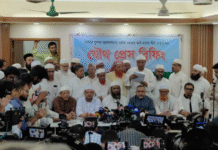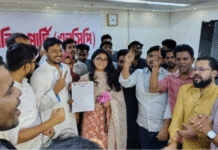Prime Minister Sheikh Hasina’s deadly response to student-led protests has grown into the biggest challenge ever to her dominance.

Reporting from New Delhi
For those watching from outside, Prime Minister Sheikh Hasina of Bangladesh presents a compelling story. She is among the world’s longest-serving female heads of government, a secular Muslim in colorful saris who has fought Islamic militancy, lifted millions out of poverty and deftly kept both India and China at her side.
But this seeming success has come at a heavy cost. During her tenure, Ms. Hasina has deeply entrenched her authority and divided this nation of 170 million people. Those who kissed the ring were rewarded with patronage, power and impunity. Dissenters were met with crackdowns, endless legal entanglement and imprisonment.
The sustained protests that have convulsed Bangladesh this month are a backlash against Ms. Hasina’s formula for power: absolute, disconnected and entitled. Her bloody crackdown, which has left at least 150 people dead, has grown into the biggest challenge ever to her dominance, just months after she steamrolled to a fourth consecutive term as prime minister.

It is a crisis largely of her own making, analysts said. The student-led protests started as a peaceful expression of opposition to quotas that reserve sought-after government jobs for specific groups. The violent response to the protests by government security forces and vigilantes from Ms. Hasina’s party sent the country to the verge of anarchy. A curfew has been imposed. The military patrols the streets, with helicopters often circling above. The internet is blocked, and phone calls are severely restricted.
Diplomats and officials say that the count of at least 150 dead is a conservative one. Local newspapers have tallied the deaths at closer to 200, and student protest leaders say the toll is most likely several times that. Hundreds have been swept into jails in Dhaka alone.
Sending In the Troops
Ms. Hasina, 76, has deployed every force at her service onto the streets, including a feared paramilitary unit whose leaders have in the past faced international sanctions over allegations of torture, extrajudicial killings and forced disappearances.
The army, which was once prone to staging coups but has been brought to heel by Ms. Hasina, has also been on the streets, mixing with law enforcement agencies that have been accused by Ms. Hasina’s opponents of becoming an overzealous extension of her power.

To protest the brutal response, a group of foreign ambassadors met with Bangladesh’s foreign minister. They expressed concern that Bangladesh’s security forces had deployed helicopters and vehicles belonging to United Nations peacekeepers in their crackdown on the student protesters, one senior diplomat aware of the discussions said.
On Tuesday, the capital city, Dhaka, remained short of crucial supplies, as the curfew hampered the transport of goods. Prices of some essentials, particularly vegetables, have nearly doubled. People lined up outside electricity and gas offices, as the internet shutdown prevented them from reloading their prepaid meters.
The communications blackout — which the government claims is intended to stop the spread of disinformation — has covered up the extent of the slaughter. Grainy cellphone footage that has managed to emerge shows security officers aiming and firing at protesters, or dumping bodies nonchalantly on the road.
At the Dhaka Medical College Hospital, an overcrowded public facility, journalists saw extensive evidence of the brutality. At least 39 people have been admitted with injuries to their eyes, from pellet guns or rubber bullets. Doctors said at least half of them were in danger of losing sight in one or both eyes.

A Traumatic History
Ms. Hasina is the daughter of Sheikh Mujibur Rahman, the country’s charismatic founding leader, who was killed in 1975 in a military coup along with most of his young family. His killing, just years after he had led a separatist war against Pakistan in response to persecution of ethnic Bengalis, inaugurated a violent Bangladeshi political culture marked by coups, counter-coups and assassinations.
Ms. Hasina, who was 28, and a sister were abroad at the time and survived the massacre. Her trauma became the driving force of her politics. Even today, four decades later, her public remarks are infused with her fixation on vengeance against the political heirs to the coup plotters.
She has helped grant her followers a monopoly over the legacy of independence, and by extension the country’s fortunes. Dissenters are still branded an extension of old forces of treason and extremism. When Ms. Hasina is accused of repressing her political opponents, she replies by saying that they resorted to worse when they were in power.
Opposition parties were not necessarily the instigators of the recent protests, but they are jumping in now, adding to the chaos and violence. Ms. Hasina’s crackdown has given them an opening after she had bogged them down with legal actions and driven them silent through fear.

The upheaval could prove dangerous to Ms. Hasina in two ways: It has focused attention on widespread economic distress as well as her own overreach.
Ms. Hasina’s economic success story had already been unraveling. The country’s reliance on garment exports seemed to have reached its limit, and the government has struggled to find alternative sources of growth. The disruptions of the pandemic and the war in Ukraine also delivered blows, causing energy and food prices to soar and foreign reserves to plummet.
Those quotas had been in place for much of Bangladesh’s history. The largest goes to the children and grandchildren of freedom fighters in the 1970s war for independence, whom Ms. Hasina has increasingly redefined to mean her own supporters.
Protests had forced Ms. Hasina to abolish the system in 2018 and replace it with one based on merit. But the courts — long seen as loyal to Ms. Hasina — reinstated the old system this summer. She was widely seen as wanting the quotas returned to reward her support base, a group she could not otherwise offer much because of the economic crunch.
When students began protesting, she described them as descendants of the “razakar,” a term that has essentially come to mean traitors during the war of independence. That enraged the protesters and served as a cue to Ms. Hasina’s supporters to attack them, analysts said. Violence and chaos followed: including attacks by crowds on the national state television building, on new subway lines and on police vehicles.

Ms. Hasina’s ministers and advisers say the state has acted only to protect infrastructure and maintain rule of law, and they have promised an inquiry into the deaths. On Sunday, the country’s Supreme Court reduced the number of government jobs reserved for war veterans. In the end, though, Ms. Hasina’s political fate may rest on whether the military remains firmly on her side, or hedges its bets as it has in the past.
For their part, the protesters are dispersed for the moment but have vowed to reassemble if their demands are not met. Some factions say the movement is no longer about the quotas — it is about justice for those killed. One group has put out a nine-point list of demands, which includes an apology from Ms. Hasina and resignations by some of her lieutenants.
Nahid Islam, a protest leader who said he had been blindfolded and tortured by law enforcement agents, said that the demonstrators would not negotiate until the communications blackout was lifted and law enforcement officers left campuses.
If those demands are met, Mr. Islam said from a hospital where he was being treated for wounds, “we can sit for discussion about the next moves of our movement.”
Mujib Mashal is the South Asia bureau chief for The Times, helping to lead coverage of India and the diverse region around it, including Bangladesh, Sri Lanka, Nepal and Bhutan. More about Mujib Mashal










